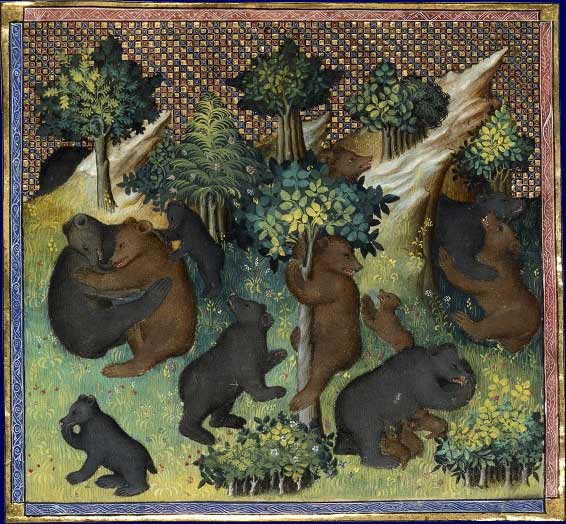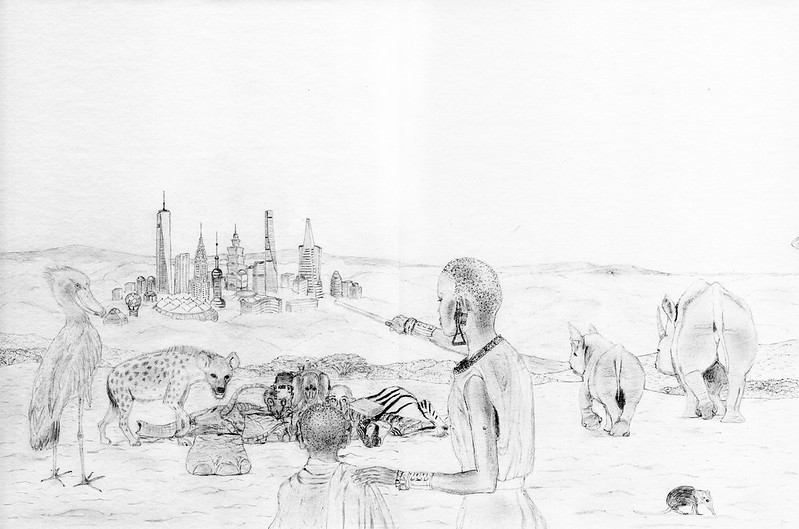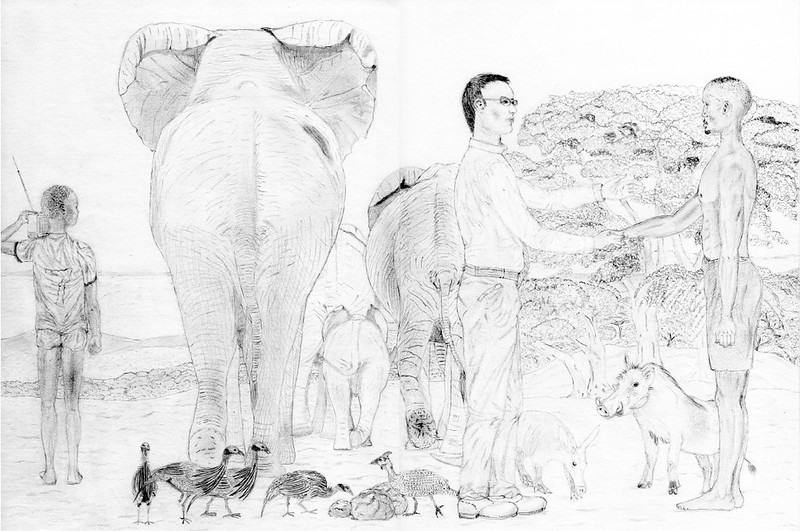Classification:
Order: Carnivora
Family: Ursidae
Genus: Ursus
Species: U. arctos
Characteristics: The largest and most endangered land mammal in France
Nursing Eurasian brown bear, Bern Zoo, Switzerland – Photo by Chandres
Population Trend:
- Estimated population in 2014: around 20 individuals, including only 3 individuals born before the reintroduction program
- Historical lowest population: 5 individuals in 1995
- Sub-Species: Ursus arctos arctos
- Conservation Status: Least Concern worldwide, population not viable in France on the long term
Main threats:
- Small genetic pool
- Ageing animals no more susceptible to breed
- Habitat fragmentation
- Hunting
- Disturbance of habitat by humans
- Traffic accident
A little bit of Classification…
The Eurasian brown bear is a subspecies of the brown bear Ursus arctos present in the Ancient World. Its range spans from Northern Spain to Hokkaido, Japan. The brown bear is also present in the northwestern part of the North America, though it was also historically present in Mexico and California. The American brown bears include the Kodiak and Grizzly subspecies.
In Europe, significant Eurasian brown bear populations remain in Scandinavia, Central Europe and Western Russia. However, the populations of Northern Spain and Southwest France are on the verge of extinction.
Outside Europe, small populations of Eurasian brown bear can be found in Caucasus, Northern India, China, Siberia and Hokkaido, Japan.
The Eurasian brown bear is quite distinct from the Asian black bear. Its body shape is sturdier, its fur is lighter, its skull and snout look more massive than the Asian species. Its shoulder hump is also more visible than its Asian cousin's. In term of behaviour, the Eurasian brown bear is a shier animal that would generally not attack humans contrary to the continental Asian black bear. Though it can also climb in trees, it is much less prone to do so than the Asian black bear.
Both species are classified in the same genus Ursus. However, the Asian black bear U. thibetanus is considered as closer to the American black bear than to the Eurasian brown bear.
The local Formosan black bear is considered as a subspecies of U. thibetanus and is classified as U. thibetanus formosanus.
The bear in French culture
Prior to the Christian era, rites involving the bear were celebrated by the ancestors of French people. These were mainly rites associated to seasons. The bear has to store fat in order to hibernate. For this reason, it was associated with harvests and the imminent arrival of winter. On the contrary, the end of its hibernation was associated to a rebirth, announcing spring and the start of a new season cycle.
Some of these rites, though quite simplified can still be seen nowadays during traditional festivals in the French Pyrenees and in the Cantabrian mountains of Northern Spain.
There are several Middle-Ages tales where the bear is a character. It is most of the time described as a powerful though clumsy and lickerish one. The fox, much wiser than the bear often plays tricks on it.

Gaston Fébus' book of hunting, France – early 15th Century
– Collection of the French National Library
Bear tamer was a job that men in poor rural areas would do. Whenever an orphan bear was collected, it was fed and then trained, allowing poor peasants to get an earning from their show. This job survived in the French Pyrenees until the beginning of the last century.
Bear tamers would usually travel from place to place, sometimes as far as to America do show their bear dancing or doing some basic tricks for the amusement of the public.
Despite the fact that people are more and more concerned about animals well being, this tradition could still be seen in Spain and in the Balkans until very recently.

Bear Tamer in Luchon, French Pyrenees, 1900 – Photo by Eugène Trutat
An historical decline on the French territory…
The French bear population is a remnant of a much larger historical population. In the middle ages, the bear was an iconic animal but it had already retreated from its original habitat in the lowland forests. It was still present in most middle and high mountain ranges of the territory. Gradually, with wood cutting and the increase of human population, it retreated further. In the middle of the 19th century, the Eurasian brown bear had disappeared from the Massif Central and the Jura to remain only in the Alps and the Pyrenees[1]. In the 1930's, it could only be found in the Pyrenees where
the last French population still exists[1]. The historical low was reached in 1995 when the population numbered five individuals[1]. This was a very late time to trigger the alarm despite this anticipated scenario. At that point, the decision was made to reintroduce wild Eurasian brown bears in the Pyrenees from existing European populations.
…and a reintroduction program started in 1996
Individuals found in Slovenia were eventually chosen. This choice had several advantages, including the proximity of Slovenia, its political stability for a long term conservation program and the fact that its bears had a good sanitary record as well as a genetic pool relatively close to the original French population.
So far, two release campaigns have been performed. The first campaign took place from May 1996 to May 1997 during which three individuals, two females and one male “Pyros” were released[1]. This video shows his release in his new French environment.
The second campaign only took place in 2006 following the death of the last female of the original population. This second release was not made in a peaceful context, as some representatives of local communities opposed it, invoking a threat for the shepherds. From April to August 2006, four adult females and one male “Balou” were released[2].
A long way to go for a secured bear population in the Pyrenees…
As of June 2014, since the reintroduction program started in 1996, at least five deaths of adult bears have been recorded, three being directly linked to humans.
The last original French Pyrenean female was killed during a hunting accident in 2004. According to the account of the hunter, she ran towards him and he had to shoot at her. However, the hunters had already been advised not to hunt in the area as this female was raising a 10 months cub. The French State and several NGO's advocating for animal species protection brought civil actions against him. The hunter was tried in court for killing an endangered species. He was sentenced to a fine of 11 000 euros in favour of the French State and the NGO's[3], his hunting association was also fined.
Two other human related deaths were a hunting accident and a collision with cars. Two deaths have been attributed to accidental fall in rugged terrain.
Despite this relatively high death rate, the population has increased from 5 in 1996 to a bit more than 20, knowing that 8 individuals were introduced. This makes a net growth of about
10 bears through new births on a time period of 18 years. However, the population is scattered in two groups and the smallest group has now no female.
A problem that still remains is the very small genetic pool of the population. It was supposed to increase with the introduction of Slovenian individuals but it happens that all new births since 1996 were fathered by dominant male "Pyros" [4]. The French brown bears did not father any cubs since then. Moreover, "Balou" a Slovenian male introduced in 2006 to bring more genetic diversity did not father any cubs and died in June 2014.
Simultaneously, growing tensions have emerged in what is now a confrontation between local shepherds and hunters associations on one side and environmental NGO's on the other side.
Shepherds and hunters are blaming NGO's for having an idealistic view of the bear reintroduction, not taking into account the economic realities of the rural communities. There have been indeed confirmed reports of sheep killed by bears. Although subsidies are provisioned to cover the damages, this does not solve the negative image of the bear in the rural environment.
NGO's reply that bears are iconic animals that give an impulse to local tourism and that they deserve to live in an environment in which they have been present for about 100 000 years.
2012, the French brown bear conservation becomes a European issue….
Despite its commitment, the French State has not been proactive enough in the pursuance of the reintroduction program. As an example, the Ministry of Environment did not replace a Slovenian female arguing that the cause of the death was natural. The death was indeed attributed to an accidental fall from a cliff just 4 months after the bear was released in 2006.
In 2012, noting only little progress in the conservation of the brown bear, the European Commission sent a warning to France: A concrete roadmap was demanded to avoid the total reimbursement of European subsidies received by France so far[1].
In 2014, the French “Museum of Natural History” , a reference institution in the field of Natural Science advocated for the release of an additional 6 Slovenian bear females[1]. The French minister of Environment has since committed to finalizing a roadmap for the pursuance of the bear reintroduction program.
The reintroduction program of the Eurasian brown bear in France shows how difficult it is to make communities accept the existence of a large mammal. Although brown bear attacks on
humans have been extremely rare in France and are still extremely unlikely in all places where it survives, it is perceived as a dangerous predator. There have indeed been some bear attacks on sheep but solutions to prevent them exist. The use of shepherd dogs has proved to be very efficient in other European countries where bear populations still remain. Communities seemed to have lost their bonds with these animals even though they are still part of their cultural heritage. In this particular case, the bear is not the victim of hunt for its use in medicine, it simply has to cope with a modified environment where roads, encounters with hunters, poisonous baits are threats.
More Informaiton:
- http://www.ferus.fr/ours/l-ours-conservation-et-presence-en-france
- http://www.paysdelours.com/fr/reintroductions/lachers-2006/
- http://www.lemonde.fr/planete/article/2010/06/02/cannelle-le-chasseur-condamne-a-verser-10-000-euros-a-des-associations_1366773_3244.html
- http://ours.des.pyrenees.pagesperso-orange.fr/Pyros.html







